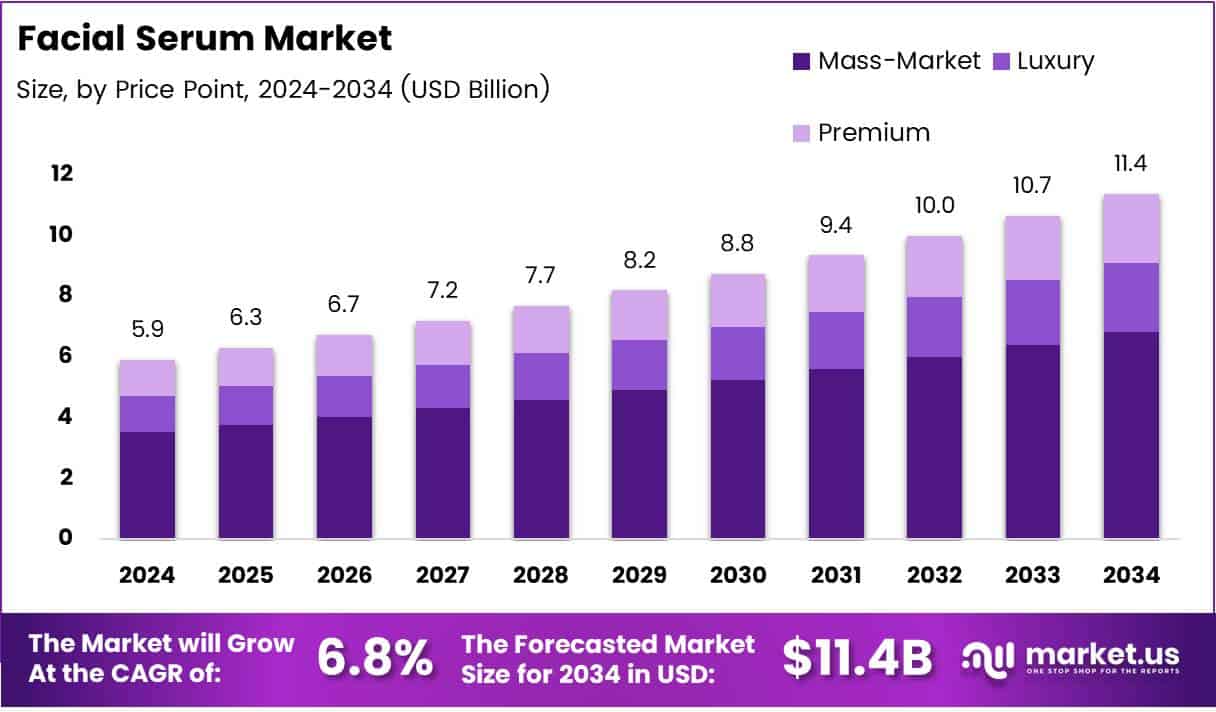The Global Facial Serum Market is projected to experience robust growth, with its value expected to rise from USD 5.9 Billion in 2024 to USD 11.4 Billion by 2034, expanding at a CAGR of 6.8% during the forecast period. This growth trajectory is largely attributed to increasing skincare awareness, social media-driven consumer education, and rising demand for anti-aging and multifunctional beauty products.
Facial serums—lightweight formulations enriched with active ingredients—are gaining significant traction globally. Their proven efficacy in addressing specific skin concerns such as aging, dehydration, pigmentation, and acne has placed them at the center of modern skincare routines. With clean beauty, ethical sourcing, and dermatological validation becoming central to consumer choices, the facial serum market is evolving rapidly to meet these emerging expectations.

Key Takeaways
- The global facial serum market is projected to grow at a CAGR of 6.8% between 2025 and 2034.
- Mass-Market products led in 2024, capturing 50.1% of the global market by price point.
- Anti-Aging Serums held the highest type-based share at 32.5%, driven by aging population and preventive skincare habits.
- Water-based serums dominated the market by form in 2024, accounting for 45.2% of total product consumption.
- Supermarkets & Hypermarkets emerged as the leading distribution channel, with a 30.1% share.
- Europe led regionally with USD 1.8 Billion in revenue and a 31.8% market share in 2024.
Key Market Segments
By Price Point
- Mass-Market
- Premium
- Luxury
By Type
- Anti-Aging Serums
- Exfoliating Face Serums
- Hydrating Face Serums
- Acne Fighting Serums
- Skin Brightening Serums
- Others
By Form
- Water-based
- Gel-based
- Oil-based
- Others
By Distribution Channel
- Supermarkets & Hypermarkets
- Specialty Beauty Stores
- Online Retailers
- Drugstores & Pharmacies
- Others
Drivers
A key market driver is the growing influence of social media and beauty influencers, which has made skincare trends more accessible and aspirational. Real-life testimonials and product demonstrations encourage higher trial rates among new users. Simultaneously, dermatologist endorsements lend scientific credibility to facial serums, making them a trusted addition to daily skincare routines.
Men’s skincare is also evolving, with more men incorporating serums into their grooming habits to address dryness, acne, and signs of aging. Lastly, consumer preference is shifting toward multifunctional products that combine hydration, anti-aging, and brightening effects, driving innovation in serum formulations.
Use Cases
Facial serums are used primarily after cleansing to maximize absorption of active ingredients. Common applications include:
- Anti-aging treatments (e.g., peptides, retinol, collagen boosters)
- Hydration support (e.g., hyaluronic acid for moisture retention)
- Brightening solutions (e.g., vitamin C and niacinamide for even tone)
- Acne control (e.g., salicylic acid, tea tree oil)
- Post-procedural care (recommended by dermatologists post-facials or microneedling)
Their rapid absorption and lightweight textures make them a preferred option for layering under moisturizers and sunscreen.
Major Challenges
The market faces several restraints, including limited penetration in rural and price-sensitive markets. Many consumers still prefer basic creams due to affordability and limited exposure to advanced skincare. Additionally, lack of regulatory standardization in emerging economies has led to concerns around product safety and efficacy.
Another growing challenge is consumer skepticism due to exaggerated claims or ingredient-related side effects. Reactions to synthetic ingredients, particularly among sensitive skin users, further limit market adoption, highlighting the need for clean, dermatologist-approved alternatives.
Business Opportunities
Significant opportunities lie in vegan and organic skincare. Rising consumer preference for plant-based, cruelty-free, and sustainable options is fueling innovation in ingredient sourcing and eco-friendly packaging. There is also increased demand for gender-neutral and Gen Z-focused skincare, paving the way for inclusive and customizable formulations.
Moreover, partnerships between brands and dermatology clinics or aesthetic centers present lucrative branding and credibility-enhancement opportunities. Brands that tailor formulations based on regional skin needs and climate conditions are likely to gain competitive advantage.
Regional Analysis
Europe leads the facial serum market, valued at USD 1.8 Billion in 2024, backed by high consumer spending on premium skincare and robust dermatological R&D. Germany, the UK, and France drive much of this growth through a mix of tradition and innovation.
North America is a close contender, with the U.S. leading due to its large, informed customer base and well-established cosmetic industry. The region’s strong focus on clean-label products and high per capita income contribute to market maturity.
Asia Pacific is the fastest-growing region, driven by a young, urbanized population, K-beauty trends, and a growing preference for online beauty platforms. China, Japan, and South Korea dominate the regional landscape.
Latin America and Middle East & Africa are emerging markets with rising awareness and beauty standards, especially in Brazil, Mexico, and the GCC nations. Growth here is supported by increasing product availability and influencer marketing.
Recent Developments
- Jan 2025: Deconstruct raised INR 65 Cr to enhance R&D and strengthen skincare distribution across India.
- Jan 2025: Unilever Ventures led a $5 Million round for RAS Luxury Skincare to scale premium offerings in India.
- Oct 2024: Hydrosome Labs secured $3.7 Million in seed funding to innovate hydration technologies in skincare.
- July 2024: SkinInspired raised $1.5 Million led by Unilever Ventures to expand visibility and talent pool in India’s skincare market.
Conclusion
As global consumers place greater value on personalized skincare and ingredient transparency, the facial serum market is poised for sustained growth. Innovations in biotech-based actives, packaging sustainability, and inclusive formulations are reshaping industry standards. With rising consumer awareness and increased investment, the market will continue evolving to meet diverse skincare needs and preferences across regions.
Discuss your needs with our analyst
Please share your requirements with more details so our analyst can check if they can solve your problem(s)



